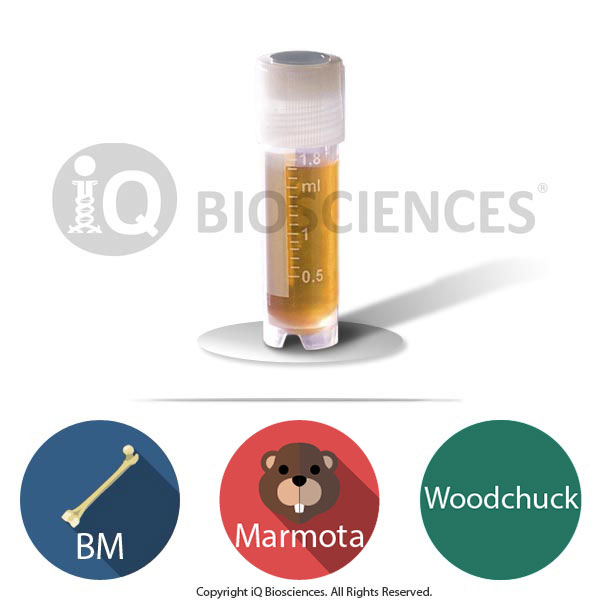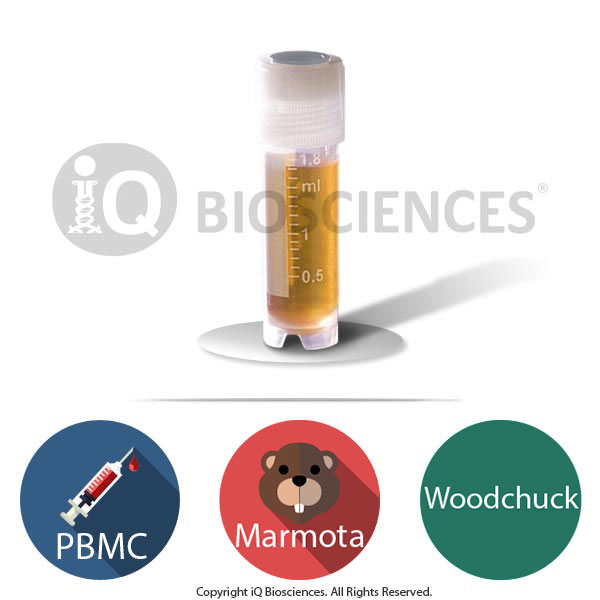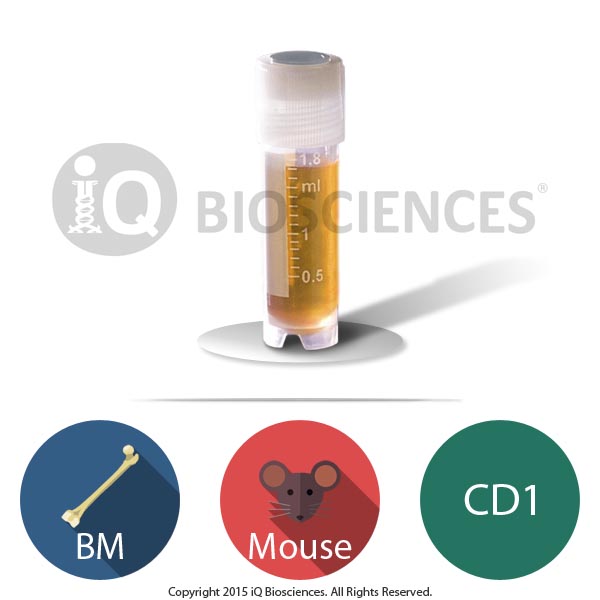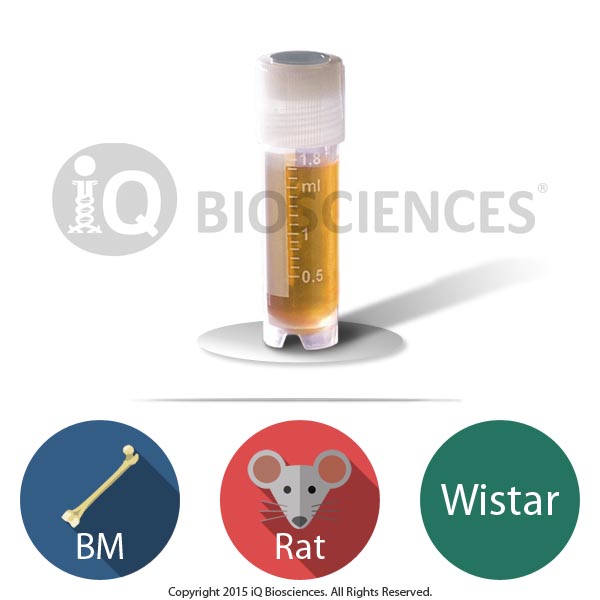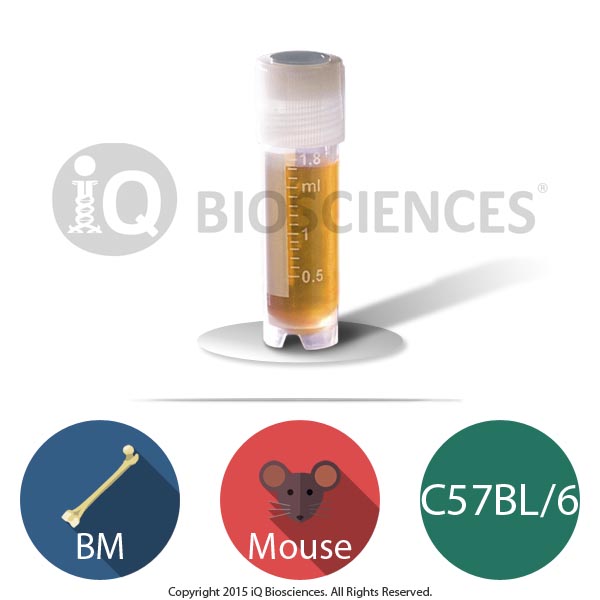- High-quality bone marrow cells from marmota monax (woodchuck) responsibly obtained from a vetted third party facility
- High viability (> 70%) after thawing
- Used for a wide variety of functional and toxicity assays in response to viral infections
- All orders come with an iQ Certificate of Analysis
- Normally ships out same business day
Woodchuck Bone Marrow Cells
$445.00
Description
About the Marmota Monax Woodchuck
Woodchucks used for research purposes are mostly caught out in the wild and outbred, which can be infected with woodchuck herpes virus (WHV). In contrast, some commercial laboratories have established in-house woodchuck colonies in order to maintain a consistent supply of woodchuck. While convenient, this method can be time and resource consuming.
WHV is an ideal model to study the pathogenesis and therapy of hepatitis B virus (HBV) and hepatitis D virus (HDV), which makes woodchuck the most commonly used animal model for the study of these viruses. Research on HBV using the WHV model focuses on disease and viral pathogenesis, in addition to prevention and treatment of HBV infection.
Similarly, toxicity studies for therapeutics against HBV and HDV are performed in woodchucks.
Additionally, since HBV can drive the development of hepatocellular carcinoma, woodchucks are a commonly used model to study this type of cancer.
Application Summary for Woodchuck Bone Marrow Cells
Woodchuck bone marrow cells can be used for a wide variety of safety assessment and functional studies. They are commonly employed in pre-clinical settings to ensure biologics are not eliciting unwanted effects or functions on the different cell populations of the bone marrow. These bone marrow cells are also utilized to test the toxicity of compounds on this particular set of cells. Additionally, woodchuck bone marrow can be used in ex-vivo applications for cell population characterization using methods such as flow cytometry or western blot analysis.
Woodchuck bone marrow cells can also be used to generate mature monocytes, macrophages, and dendritic cells from progenitor cells of the marrow. These cells are then typically used in co-culture assays with other immune cells to assess their function. In particular, generated dendritic cells are often employed in studies to study antigen presentation in response to WPV.
Isolation of Bone Marrow Cells
Woodchuck bone marrow is responsibly collected at third party facilities, who are vetted to ensure they operate according to local regulations and laws. More importantly, the bone marrow is processed within 24 hours of isolation at iQ’s facility.
At our facility, the bone marrow is carefully examined and a single cell suspension is obtained under sterile conditions. The suspension is carefully passed through a filter to remove any aggregates and subsequently depleted of red blood cells. The bone marrow is then frozen based on iQ Biosciences’ quality-controlled cryopreservation protocol to promote recoverability and viability once in the end user’s hands.
Cryopreservation and Storage
Our woodchuck bone marrow cells are cryopreserved carefully using iQ Biosciences’ cryopreservation protocol that ensures high viability (> 70%) after thawing.
Cells should be stored at < -120°C once they are received, such as within a liquid nitrogen tank (vapor phase).
Additional information
| Available Size(s) | |
|---|---|
| Format | |
| Cell Type | |
| Tissue Type | |
| Species | |
| Viability | > 70% |
For US customers, we ship via FedEx Overnight Shipping. Shipping charges will vary per shipping address (based on ZIP code) and are estimated to be $140.
For international (non-US) customers, we work closely with you and our couriers to ensure all necessary documentation is in place for international shipments to significantly reduce the chance of delays at Customs. For the export of non-human primate samples, this includes preparing CITES permits, as well as any other documentation as required by country. Please submit an inquiry to orders@iqbiosciences.com for your estimated time of delivery and shipping charges.
Austria
Hölzel Diagnostika Handels GmbH
Tel: +49 221 126 02 66
Email: info@hoelzel.de
Web: https://www.hoelzel-biotech.com/
Canada
Cedarlane
Tel: +1 (289) 288-0001
Toll Free (North America): +1 (800) 268-5058
Fax: +1 (289) 288-0020
Email: sales@cedarlanelabs.com
Web: https://www.cedarlanelabs.com
China
BIOHUB INTERNATIONAL TRADE CO., LTD.
上海起发实验试剂有限公司
Address: Chuansha Rd #6619, Pudong, Shanghai, Zipcode: 201200 P.R.China
Tel: 0086-021-50724187
Phone: +86-15921799099
Fax: 0086-021-50724961
Email: sale3@78bio.com
Web: www.qfbio.com
European Union
Caltag Medsystems Ltd.
Email: office@caltagmedsystems.co.uk
Web: https://www.caltagmedsystems.co.uk
tebu-bio
Web: https://www.tebu-bio.com
Or Find a local contact
Germany
Hölzel Diagnostika Handels GmbH
Tel: +49 221 126 02 66
Email: info@hoelzel.de
Web: https://www.hoelzel-biotech.com/
Zageno
Web: https://zageno.com/
Ireland
2B Scientific Ltd
Tel: +44(0) 1869 238033
Fax: +44(0) 1869 238034
Email: sales@2BScientific.com
Web: https://www.2bscientific.com
India
Cell & Gene BioSolutions Pvt. Ltd.
#478 C, SLV Complex, Raghavendra Swamy Mutt Road
Opp. Turahalli Water Tank, Turahalli, Subramanyapura Post
Uttarahalli Hobli, Bengaluru-560061, Karnataka, India
Phone: +91 97317 14670
Phone: +91 98809 25033
Email: info@cgbios.com
Web: www.cgbios.com
Japan
Cosmo Bio Co., Ltd.
Tel: +81 (03) 5632 9610
Fax: +81 (03) 5632 9619
Email: nsmail@cosmobio.co.jp
Web: https://www.cosmobio.co.jp
Qatar
Sedeer Medical Services and Trading LLC
Tel: +974 4434 9191
Email: info@sedeer.com
Web: https://sedeer.com/
Singapore
Omnicell Pte Ltd
Tel: +65 6747 0201
Email: enquiry@omnicell.com.sg
Web: https://omnicell.com.sg/</a
South Korea
BioClone
Tel: +82-2-2690-0058
Email: bioclone@bioclone.co.kr
Web: http://www.bioclone.co.kr
Switzerland
Hölzel Diagnostika Handels GmbH
Tel: +49 221 126 02 66
Email: info@hoelzel.de
Web: https://www.hoelzel-biotech.com/
Taiwan
Hycell International Co. Ltd.
Tel: +886-2-2877-1122
Fax: +886-2-2876-1520
Web: http://www.hycell.com.tw
United Kingdom
2B Scientific Ltd
Tel: +44(0) 1869 238033
Fax: +44(0) 1869 238034
Email: sales@2BScientific.com
Web: https://www.2bscientific.com
Caltag Medsystems Ltd.
Tel: +44 (0)1280 827460
Fax: +44 (0)1280 827466
Email: office@caltagmedsystems.co.uk
Web: https://www.caltagmedsystems.co.uk
tebu-bio
Tel: +44 (0)1733 421880
Fax: +44 (0)1733 421882
Email: uk@tebu-bio.com
Web: https://www.tebu-bio.com
Zageno
Web: https://zageno.com/
United States
Fisher Scientific
Tel: 1-800-766-7000
Web: https://www.fishersci.com
Quartzy
Web: https://www.quartzy.com
VWR International
Tel: 1-800-932-5000
Web: https://www.vwr.com
Zageno
Web: https://zageno.com/
